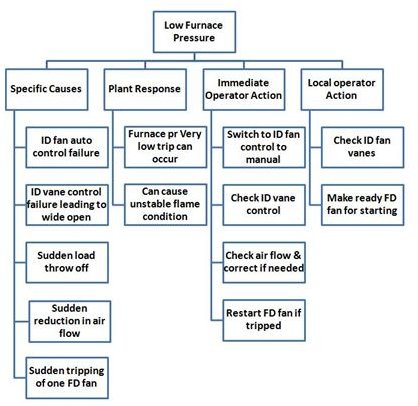Boiler Operation with Low Furnace Pressure
Balanced draft boilers are prone to a very low pressure condition inside the furnace. This condition creates a large amount of force on the waterwalls of the furnace. The buckstays which are provided in the boiler furnace are designed to handle both high and low pressure conditions that can damage the furnace. However if the low pressure continues, and if it exceeds the limit the buckstays can withstand, then the furnace is subject to implosion. Implosion happens when a large pressure acting on the walls of the furnace from outside overcomes the very low pressure prevailing inside the furnace. This leads to a high differential pressure between the atmospheric pressure outside and the pressure inside the furnace.
Some of the furnace implosions have led to replacements of the furnace walls and have caused large financial losses to the owners. It is also possible to get into a furnace implosion condition in positive pressure boilers. In fact, in balanced draft furnaces the availability of openings softens the effect to some extent when they are near breakeven points. The damage to the furnace is nearly the same if implosion happens.
The reasons of furnace implosion are many.
- Induced draft fan control failure is one of the common causes in a balanced draft boiler
- Induced draft fan vane control failure also leads to furnace low pressure condition in balanced draft furnace.
- Sudden load throw off leading to a large fuel cutting is another common cause of low furnace pressure in both positive and balanced draft boilers
- Sudden reduction in air flow
- Sudden tripping of one forced draft fan, leading to a large reduction in air flow
The plant responds to these conditions by a large reduction in furnace pressure and leads to unstable furnace flame conditions.
Depending on the indication and the reason for the cause of the problem the boiler operator will have to respond.
- Switch to induced draft fan control from auto mode to manual mode if the control system is the reason leading to low furnace pressure and take corrective action. Ask the controls engineer to rectify the fault before again turning on to the auto mode.
- Check the induced draft fan vane control system for proper functioning by changing the set point and finding the response. Rectify if required.
- Check the air flow condition and ensure the correct air flow to the boiler as per the load condition
- If one of the forced draft fan has tripped then after establishing the reason for trip and correcting the same, restart the forced draft fan.
The local operator in the field invariably has to check the induced draft fan vane control if this was the reason causing the low furnace pressure. If one of the forced draft fan has tripped, then he has to make ready the fan for restart after ascertaining the reason for the trip.
Low Furnace Pressure Flowsheet
Related Concepts
There are many causes that can contribute to flame failure in boilers and require operator action. Operating the boiler with unstable flame is always dangerous and can lead to boiler explosion. Tripping the boiler is the option for all boiler designers and operators. High furnace pressure in boilers is a direct indication of a disturbance in combustion performance. The rate of change in the furnace pressure can vary from a simple sudden surge due to fuel variations to a huge furnace explosion. All forced draft fan trips in a boiler will cause a boiler trip. Putting the boiler back in operation and giving steam at the required parameter to the consumer is very important. Boiler operators should know how to handle both forced draft fan trips in a running boiler as delay in this can cause a very high loss to the plant.
